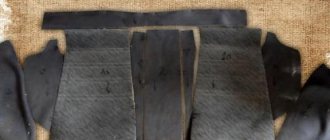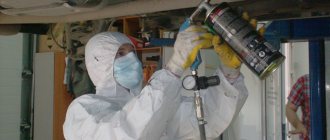Cars admin26.02.2020
Sooner or later, the painted coating on a car body becomes cloudy and microcracks form on it, which after some time become very noticeable and greatly spoil the appearance of the car. If nothing is done, moisture, dirt and sunlight will contribute to the expansion of cracks in the paintwork. Car enthusiasts try to combat the resulting microcracks with polish. However, the effect it gives is temporary. In order to completely eliminate them from the paintwork and prevent the spread of microscopic cracks, chips and scratches, you need to treat the surface with liquid wax.
What effect can you expect from waxing?
Wax treatment is the best way to keep your car's paintwork presentable. But this is not just about aesthetic characteristics. Wax provides protection to the body and prevents premature aging of the coating.
It is best to entrust the work to specialists who have the necessary qualifications, production space, and equipment. Compliance with application technology in combination with high-quality ingredients guarantees long-term operation while maintaining a classy appearance.
The result of treating a car with liquid wax
Pros and cons of car waxing
This method of protecting paintwork has more than enough advantages. It is popular among domestic car enthusiasts for the following reasons:
- creates a durable and aesthetically attractive coating, restores its shine;
- the number of dirt particles penetrating into cracks and irregularities is reduced, which makes it easier to maintain the car;
- it takes less time to dry the vehicle;
- a high-quality protective coating is created from harmful ultraviolet radiation, dust and dirt.
How effective is body protective treatment?
Our center staff will offer a full range of protective coatings suitable for a specific vehicle. All of them are really capable of protecting the body for a long time from exposure to moisture, dirt and even small stones. The water forms droplets and rolls off the body very quickly. Waxing will also keep your car clean longer. The coating will make the color richer and brighter, giving the effect of a new car.
One application will last about six months or even up to one year, it all depends on the season, frequency of washing and intensity of use. During this period, it will be much easier to remove any contamination, including bird droppings, petroleum products, etc. The cost of the service will be affected by the type of materials used, the work time and the tasks assigned to the master. You can find out the exact price by contacting our company consultants.
Types of liquid wax
Which car wax is the best is a question motorists traditionally ask. Today there are 3 main types of this auto chemical product, each of which has its own characteristics:
- Cold car wax is characterized by a significant content of surface substances, which in their active composition are cationic. The other most important ingredient is the emulsion. The application of this product perfectly fills the smallest cracks, scratches and any type of unevenness. Even the best cars in terms of cost and body coating performance can be treated with cold wax. A reliable protective layer is created, the shine of the body increases, washing is easier and the drying process is accelerated. The manual method is used for application and polishing. It is advisable to repeat the procedure after several washes to consolidate the effect.
- Hot car wax is a paraffin-containing substance of soft consistency that can be either artificial or natural in origin. Even the artificial variety is one of the best types of synthetic wax. High-quality types of these products contain so-called carnauba wax. It is characterized by a high melting point, special transparency, and increased resistance to mechanical damage. Such chemicals usually melt in the temperature range of 40-90 degrees Celsius. The protective qualities of such a coating remain unchanged for 6-12 months. Hard, hard paste wax must first be brought into a different state - for this it is diluted with hot water. You can apply it with a clean rag or napkin, and then carefully polish the body with slow circular movements. Special additives that have an anti-corrosion purpose can be added to expensive types of polishing agents. Liquid hot wax is more expensive than cold wax due to the components in its composition.
- By analogy with the hot variety, the so-called foam wax has similar qualities. It is no longer applied manually, but using specific equipment. To do this, synthetic wax, liquid or solid, is diluted with water to form an emulsion. Air is mixed into it, and the finished combination is sprayed over the surface of the vehicle body. It is the foam emulsion that is considered the most effective in the rating of synthetic car waxes in terms of creating a protective layer. It not only sprays evenly, but also adheres perfectly to the surface.
With the exception of foam emulsion, any other spray wax is easy to apply and distribute by hand. However, in order to count on long-term operation, the machine is thoroughly washed and dried before performing the procedure, after which it is ready for procedures. Before applying the product, shake the bottle of liquid car wax thoroughly.
Procedures should not be performed under direct sunlight. It is advisable to start applying the protective agent from the roof, gradually descending to the bottom in small sections. First, the product is sprayed over the entire surface of the body, and after 15-20 minutes it can be rubbed in with gentle circular movements. In fact, both hot and cold wax are excellent for manual processing. Manufacturers of auto chemicals pay attention: the ambient air temperature during the treatment process should not differ from the temperature of the product itself by no more than 20 degrees in one direction or the other.
The obvious benefits of waxing your car
- • Polishing the body with wax allows you to apply the composition to chrome elements. This significantly reduces processing time, because there is no need to additionally protect them.
- • Car wax polishing is the most affordable type of protective body treatment. The price for such polishing usually starts with the price list for the services of most car washes and detailing centers.
- • Wax polish is not an expensive reagent and is usually available in large quantities at every major car wash - in Moscow or a small town a thousand kilometers from the capital.
- • Waxing can be repeated many times. When polishing a car with wax, the varnish layer is not affected - abrasives do not come into contact with it.
- • Polishing a car with wax does not require any special skills. For the result to meet your expectations, it is enough to follow the manufacturer’s simple instructions. It is worth noting here that the affordable price of the service calls into question the meaning of time spent on polishing: if possible, entrust it to specialists.
- • Wax polishing has the special quality of adding color to vibrant shades. If your car is red, sky blue or peach, then after waxing its edges will glow especially brightly.
Which car wax is best?
There is a wide choice on the market of products intended for car care, and it is not always possible to find a definite answer to the question “what to wax” - what is the best way to wax this or that car. Not all of them hold and apply equally. It is better to determine in advance the polishes for polishing a car in terms of their performance characteristics:
- wax in spray form. It is considered the worst choice, since after 1-2 washes or the same amount of rain there will be no trace left of the protection. The processing will have to be repeated again and again;
- liquid form of a wax product. It is considered the best wax for creating a protective layer. For a long time, it will delight the motorist with the impeccable appearance of his vehicle, subject to technology, time and effort. The clean car is thoroughly dried, and then the product can be applied in a liquid state. To make the body shine like new, it is additionally blown with a stream of air;
- solid waxy product. Recommended for those car enthusiasts who are constantly searching for an answer to the question of which wax is best to protect the body in any climatic conditions. It must be applied to a dry and cleaned surface, and immediately after that thoroughly polished;
- hot waxing creates the brightest shine possible. To use, the product must be diluted with hot water.
When choosing auto chemical products for your iron horse, you need to pay attention to its color. The white car body needs protective equipment more than others. On such machines, traces of the negative impact of environmental factors appear most noticeably. High-quality waxing will highlight the color and give the coating a “diamond shine” effect, create a high-quality protective layer and protect against dust particles from settling.
The best prices and conditions for the purchase of new cars
Liquid car wax is a substance intended for treating the paintwork of a vehicle. It helps maintain the original color of the car and also neutralizes defects and damage. The material belongs to the “autochemicals” category, therefore it requires special storage and use conditions.
How to choose car wax
First you need to choose the type, synthetic or natural. Then see how it is more convenient for you to apply, with a spray or sponge, or wash with the prepared solution. Then you choose how much you would like to pay maximum for this product. The downside of natural is that it wears off quickly.
The color of the car also influences the choice. Some waxes have a small number of colors, so they will not work.
Wax life
Usually they write on the packaging that it can withstand, for example, up to 10 washes. To prevent the wax from being washed off quickly, you must wash the body thoroughly so that no dust remains.
Why is this necessary?
The paintwork of a car has a limited service life. Over time, the paint fades and damage forms on the surface. Car body wax is used to remove:
The substance fills defects in the car coating, resulting in the formation of an even, smooth surface. The hydrophobic protective film formed after the mixture hardens adds brightness and shine. Additionally, coating the car with wax provides the body with protective properties. The impact on the paint layer of the car is minimized:
- ultraviolet;
- chemical substances;
- dust and dirt;
- detergents.
It is necessary to cover the body with liquid car wax at least twice. This condition results in the presence of a complete protective film on the surface of the vehicle.
How to prepare car body polish
Before you start making your own car polishing composition at home, you should know that this product must contain an abrasive and a binding component. In its role, you can use fats, water or silicone.
Please note that fats cannot be removed with water - this will need to be done with a dry rag. So, let's start preparing the car polishing paste:
Read more: Rear trailing arm Lancer 9
- We prepare the abrasive . To do this, we produce fine-grained chromium oxide. We get it using this algorithm:
- burn chrome-containing paint over a fire or with a soldering iron;
- We take ammonium dichromate purchased in advance and set it on fire. We wait until it oxidizes;
- evaporate the hydrochloric acid formed during the oxidation process.
Polishing the car body
- Preparing the binding component:
- 0.2 stearine - it can be obtained by boiling laundry soap and then mixing the resulting substance with acetic acid;
- 0.1 laundry soap;
- 0.7 chromium oxide;
- 3 drops of kerosene.
Mix all parts while heated. Great care must be taken here - stearin is a flammable substance.
After all the above operations, the polish for the car body is ready - you can use it.
Types and popular manufacturers
Polymer wax is produced and sold in different forms. There are three types of classification: by method of application, form of manufacture and composition. According to the first sign, the material can be:
Depending on the form of production, the following types of wax are distinguished:
Based on its composition, the liquid material is divided into 4 categories:
- mineral;
- synthetic;
- animal;
- vegetable.
Each type has its own characteristics. To choose the best option, you need to consider the advantages and disadvantages of each.
Cold
Cold wax includes a group of liquid substances. They are produced based on the synthesis of cationic active substances and emulsion wax. The material is applied by hand. The substance is removed from the body after washing the surface of the car. To maintain protection, the mixture is regularly applied to the surface of the car. It is recommended to coat the body with the substance after washing.
The mixture fills microdamages. Its disadvantage is its short-term effect. For this reason, high consumption of the substance occurs.
Clay polishing
To make the body as smooth as possible, it is treated with clay, which absorbs the smallest debris embedded in the coating: grains of sand, particles of paint, insects, adhering dust. It’s easy to check for inclusions: if the surface seems rough under your palm or fingertips, you need to polish it so that when applying wax you don’t catch the body with fiber, and reduce the consumption of materials by 2-4 times. Glaze, sealant and wax will be applied in thin layers easily and evenly.
Bitumen that has contaminated the body must be removed with special cleaners (this is very expensive) or white spirit. Galosh gasoline also works well. The composition of professional products is no different from gasoline, but a special can with a spray is more convenient. The cleaner is applied to the surface for 3-5 minutes, then the draining bitumen is wiped off with a wet rag. If one treatment is not enough, repeat again. The body, cleared of bitumen, is washed very well with water and dried. There should be no traces of solvents left on the paintwork.
Clay loses its properties when it comes into contact with solvents (white spirit, antisilicone), so even small traces of their application must be washed off with water.
Clay is not afraid of bitumen; it can be used to remove contaminants, but small pieces remaining in the lump will turn the clay into an abrasive and will have to be replaced. This method is pointlessly expensive.
To avoid getting an additional portion of scratches instead of a polished surface, a lubricant is applied to the body. The slippery layer makes work easier and protects the body from risks. And again, the car enthusiast is faced with a choice: professional lubricant or “home” products. The branded product does not leave streaks or stains, but is not cheap. Using it for household purposes is a waste of money.
Store-bought lubricants can be well replaced with solutions of foaming detergents: an aqueous solution of baby liquid hand soap (4:1), dishwashing detergent, for example, Ferry (400:2). Since after polishing the paintwork must be degreased with anti-silicone, small stains are not critical.
An aqueous solution of lubricant is applied to the body and the paint surface is polished with clay over the wet film. Professional clay in the budget segment works no worse than expensive clay. The optimal cost for its acquisition will be no more than 2000 rubles. A briquette weighing 250 g is enough for 6-8 uses. You can store leftover clay in a tightly closed jar. To prevent the clay from drying out, it is filled with water. Shelf-life Unlimited.
It is easier to knead the clay with hot water. The resulting cake should fit comfortably in the palm of your hand and slide easily over the body covering. From time to time, the flatbread should be folded with the working side inward, then kneaded, leaving the adhering micro-debris inside - this will prevent the appearance of marks. Fallen clay cannot be used.
Anti-silicone is applied to the polished body - a product that removes the remains of inorganic films. Old waxes, shampoos, polishes can be easily washed with a microfiber cloth (towel) soaked in anti-silicone. The liquid can be sprayed onto the body. You need to rub the cleaning agent until it evaporates completely and only with vertical or horizontal movements. When using circular movements, a grain of sand caught under the napkin can severely scratch the coating.
How to apply
The mixture is applied to the car body in two ways:
- manual; using special tools.
- The second method is used only for the hot look. In all other cases, the surface of the car body is processed manually.
The body is first cleaned of dirt and dust and dried. A high-pressure washer is best suited for this purpose, allowing you to remove dirt of any complexity. Then the coating is processed. Each type has its own instructions. Regardless of which material is chosen for surface treatment, it is correct to apply the mixture indoors or under a canopy, where the sun's rays do not reach. When exposed to the sun, the substance hardens quickly, forming a matte rather than shiny surface.
How to apply liquid wax to a car
Liquid wax is diluted in water. The water temperature is indicated on the packaging. The substance is applied to a damp surface. The difference between the temperature of the coating and the water with the diluted mixture should be no more than 20 degrees.
The car body is treated with liquid wax in sections. When rubbing the surface of the car, take breaks of up to 2 minutes between individual zones. Waxing a car starts from the roof. Applying and rubbing the mixture is done using:
If excess mixture remains, it is carefully removed. The processing time is up to 30 minutes. In order for the substance to adhere better to the body, it is recommended to blow it with air.
Applying hard wax
Coating a car with hard wax is done indoors. To apply the substance, use a dry sponge or soft cloth. It is prohibited to use hard material for this purpose. The mixture is applied to a dry surface.
Depending on the type, it may be necessary to pre-melt the material. Its melting point is between 40 degrees Celsius. Application is carried out in separate sections, between which there should be no visible transitions.
The minimum temperature at which wax can be applied to a car is 6 degrees Celsius.
How to use hot wax
Hot wax for a car is selected depending on the color for which it is intended. This condition is indicated on the product packaging in the specifications. The substance is applied to the dry surface of the vehicle in a ventilated area.
The application technology for this type is standard. The mixture is diluted in a container with warm water and applied to the paintwork using a soft sponge. The surface is then polished and dried for a certain period. The best time for processing is autumn.
Applying cold wax
Cold car wax remains on the surface of the vehicle for a short period. To maintain protective properties, the substance is used after each car wash.
You can wax your car using a soft cloth or sprayer. After applying the liquid to the body, the remaining mixture is carefully washed off.
It is better to wax the car with a sprayer, this way the procedure is completed faster.
Composition and application
The polish will protect the car from the accumulation of dust, dirt and the possibility of rust, as it repels water.
Before preparing a polish, you should determine for what purpose it will be used. The presence of an abrasive substance in the composition depends on this.
Polish is divided into:
- abrasive;
- wax;
- for headlights;
- synthetic (can’t be made at home).
1. The abrasive is produced by burning chromium-containing paint or ammonium dichromate.
Read more: Long nail on the little finger in men
If ammonium dichromate is chosen as an abrasive, then its preparation will take place in two stages:
- oxidation during combustion;
- evaporation of hydrochloric acid.
2. The binder composition is prepared from the following components:
- 2 parts stearin;
- 1 part acetic acid;
- 7 parts chromium oxide;
- a few drops of kerosene
3. There are other recipes for making car polish. They are made from clay or beeswax.
The wax product is made with the addition of turpentine or vegetable oil. The oil component is combined with the same volume of hot wax and mixed.
To work with all of the listed substances, you will need gloves and a mask or respirator.
In order to cover a car with polish, you will need sponges and microfiber rags. A polishing machine will save time and effort when applying the composition.
There is a certain procedure for applying polish to a car. After a motorist has learned how to make car polish himself, he should familiarize himself with the rules for applying it:
1. First of all, the car must be washed and completely dried.
2. All polishing work should be carried out in a well-ventilated area, or outdoors under a canopy in calm weather.
3. The air temperature should not be below 10 and above 30 degrees.
4. Direct sunlight should be avoided so that the machine body does not heat up.
5. It is recommended to degrease the surface with a special compound.
6. The entire area of the body must be divided into equal sections and processed each in turn.
7. The polish is applied for 15 minutes to be absorbed, and then the cars need to be polished.
8. The polishing machine is only suitable for large surfaces.
9. Difficult areas are best treated with felt or microfiber.
10. The completion of the work will be the application of a fixative, which will give the car a special shine.
The car's headlights also need to be polished. At home, regular toothpaste will help with this. The paste must be applied to the headlight and rubbed - these steps can be repeated several times and the paste can be washed off with water.
11. Based on the above, it becomes clear that preparing a polishing composition with your own hands will not take much time.
You can learn how to make car polish and apply it correctly using training videos on the Internet or from fellow motorists.
Every car enthusiast knows that polishing a car body helps solve several very important problems. By applying car polish to the surface, you will simultaneously ensure:
- protection from external atmospheric influences;
- protection against damage to the body by aggressive environments;
- corrosion prevention;
- long-term preservation of the integrity of the car’s paintwork;
- removal of scratches, chips and microdamages;
- protection of car paint from fading;
- spectacular shine.
Car body polishing
Modern industry offers consumers a wide selection of products for polishing car bodies. This is a polymer polish, car wax, liquid glass, as well as various other options.
However, some car owners do not really trust industrial products, preferring to prepare polish and apply it to the surface of the car body at home.
How to remove wax from a car
Old car wax is removed if, after the expiration of the operational period, it remains on the surface of the car. It is impossible to carry out treatment with a new substance if the old protective coating remains.
To remove it use:
- special spray cleaner;
- clay.
In both cases, the substance is applied to the surface of the car and left there for a while, after which it is washed off with a rag or towel with microfibers.
Do not use standard detergents to remove old coating.
How to make liquid car wax with your own hands
If for some reason you do not want to use ready-made products, you can make your own wax at home on the stove. However, keep in mind that no matter how hard you try, home preparation will be less effective. The Internet is replete with articles and video tutorials on how to make liquid wax yourself. The easiest and most affordable way is to make a homemade product based on coconut oil. In order to make a wax composition using the specified method, you will need:
- steamer or steam bath utensils;
- the wax itself, of natural or artificial origin (vegetable, bee) – 5 grams;
- natural coconut oil – 50 grams;
- carnauba flakes – 20 grams.
At the initial stage, you need to send the carnauba flakes with wax to a steam bath to melt. When the liquid becomes homogeneous, stir in the required amount of coconut oil. After adding coconut oil, the solution must be constantly stirred until it becomes homogeneous again. When the liquid reaches a uniform consistency, it must be removed and allowed to dry. Cured wax can be used. After a few hours, the liquid will harden, in this form it is very convenient to store, and before use it is enough to simply warm it up. Making homemade wax for polishing is a complex and time-consuming process that will not give a 100% result. Yes, and to prepare a decent product you need to get your hands on it.
Share with friends on social networks:
Telegram
Advantages and disadvantages
- high processing speed;
- budget cost of production;
- ease of application of the substance to the car;
- high-quality damage repair;
- the appearance of the coating is updated.
- short operational period;
- inability to repair major damage;
- the risk of damaging the coating if dirt gets on the uncured surface.
If it is necessary to eliminate not only microcracks and scratches, but also major damage, it is better to cover the car with hard wax.
>











